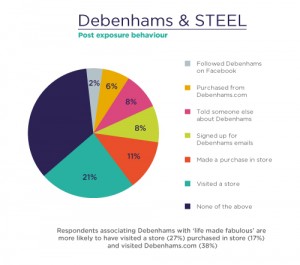John Ferguson
Online advertising is now a £4 billion industry in the UK and growing rapidly. Digital advertising accounts for 27% of the UK market, topping TV for the first time in 2011 at 26% and eclipsing press display at 17%. Not
surprisingly, given these levels of investment, brand owners are looking for a greater understanding of the effectiveness of their online campaigns as part of the overall marketing mix – leaving researchers and advertisers
asking themselves a number of key questions: Are their digital campaigns reaching their target audience? How well are the messaging and creative elements working to influence perception, and build brand awareness and loyalty? What is the impact of frequency of exposure on recall and message takeout?
Understanding more than reach: looking for insight about ad effectiveness with targets and in real time
Traditional measurement tools used to track display ads incorporate basic web analytics. These tools focus on audience delivery, and provide data on top-line information on the reach and the frequency of the exposed audiences. However, they do not enrich the understanding of how effective the ads have been on brand perception
![Research Now - chart 2 for RWC 28June2012[1]](/wp-content/uploads/2012/07/Research-Now-chart-2-for-RWC-28June20121-293x300.jpg)
We have been able to demonstrate the real value of digital advertising to clients by utilising ADimension technology, which has been developed to measure exposure to an online campaign by using opted in browser cookies on our panellists’ computers. By embedding tags into the online creative and via the browser cookie, an impression is recorded every time a panellist visits a web page on which the advertisement is being displayed – this is logged telling us who has been exposed, and when and where the exposure has taken place. Tailored surveys are then sent to both exposed panellists and unexposed panellists, and the data sets are compared to determine differences in behaviour or attitude that can be linked back to exposure of the campaign. We then have the added bonus of being able to append the rich demographic profiling data (over 300 individual variables) we hold on all of our two million plus cookied panellists. How will this help organisations with their online advertising efforts moving forward? Let’s take a closer look at one particular example, involving retail giant Debenhams.
Setting a benchmark for future online campaigns: a retailer’s story
Debenhams, the UK-based retailer, launched an online display campaign that was integrated with a TV campaign, ‘Life Made Fabulous’. The campaigns used similar creative work, reconfigured for the digital medium. The online campaign was seen as a success when measured by uplifts in the click-through rates and in terms of lowering the cost per action , but the question remained, ”How far had it met the objectives around brand building?” The marketing team, and its creative and media agencies, needed to measure delivery against the campaign objectives and not just the campaign action. The aim was to derive creative insights that could influence and improve the performance of the digital advertising as part of the overall marketing and communications strategy moving forward.
The main objectives for the ‘Life Made Fabulous’ online campaign were to amplify the TV advertising, raise awareness about Debenhams’ showcase of designers, and in particular, influence the key campaign target audience of women aged 18 to 35 and women 25 to 45. Debenhams also hoped to determine whether increased exposure to the online advertising meant better ad recall, if the messaging about designers was making a mark, and how the advertising influenced both brand opinion and post-exposure shopping behaviour.
Debenhams worked with digital specialists, STEEL, and Research Now. The rationale was that the study needed to involve panels rather than a site-intercept method to provide the benefit of stability for tracking and ensure a robust sample for the exposed cell. Also important was the ability to profile the campaign universe (all individuals exposed to the ad campaign, and not just the survey respondents).
So how did the numbers compare? Spontaneous awareness of Debenhams within the exposed group was 21% higher within the exposed group when compared with the control group, indicating a favourable result.
The messaging about Debenhams’ association with designers also scored very well for spontaneous awareness (82%), prompted awareness (84%), and for Debenhams shoppers as a whole (82%), increasing to 87% for online shoppers. The ‘Life Made Fabulous’ campaign achieved 31% spontaneous awareness; and when prompted, this rose to 33%. Of Debenhams shoppers, 27% were aware of the campaign.

This study also provided insight into the effect on post-campaign behaviour. 32% of those exposed visited Debenhams.com, 21% visited a Debenhams store, and 11% had purchased in store. Additionally, respondents who associated Debenhams with the key messaging ‘Life Made Fabulous’ were more likely to have visited Debenhams.com (38%), visited a store (27%), and purchased in store (17%).
The findings also provided valuable insight into how well the campaign had reached the target audience.
STEEL were also able to look closely at the impact on women ages 18 to 45 who had been exposed to the advertising. For the 18 to 35-year-olds, they were able to conclude that 66% already shopped in store with 84% now likely to shop in store, and 25% already shopped debenham.com with an impressive 57% now likely to shop at Debenhams.com. For the second age band of interest, 25 to 45 years, 60% already shop in store, with 81% now likely to shop in store post exposure and 25% already shopping at Debenhams.com – and once more, with an impressive 61% now likely to shop at Debenhams.com post exposure.
Guiding future creative
The research gave clear evidence that better targeting and higher engagement results in better ROI. The digital campaign could work to shape awareness and build the messaging, and to strengthen consumer relationships with the brand. Most importantly, it was able to guide the team in how they could build those relationships in subsequent campaigns. High engagement was driven not just by targeting, but by the ability of display to pull audiences into the brand’s media and communications channels.
As one of the current ‘holy grails’ within the global media industry is being able to effectively track and report on the impact of cross-channel media spend in this digital age, researchers are pushing the boundaries to provide a 360 degree analysis of online ad effectiveness as part of the overall marketing mix. At a time when consumers can be engaged with campaigns in more ways than ever, and from more sources than ever, an approach which brings together the verification of audience buying with data from opted-in panellists is one that can provide marketers with the learnings they need for campaign planning.
John Ferguson is Associate Client Development Director with Research Now


